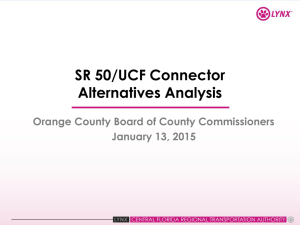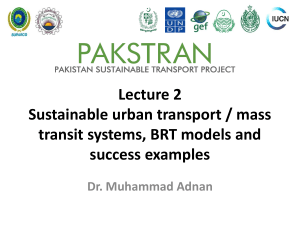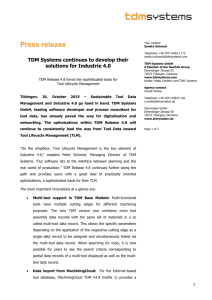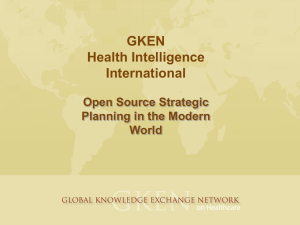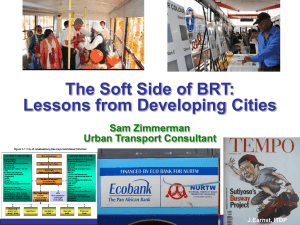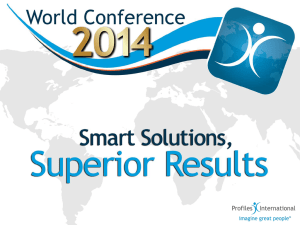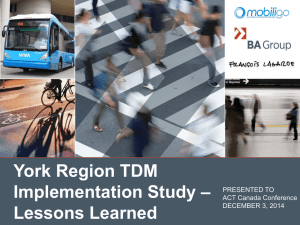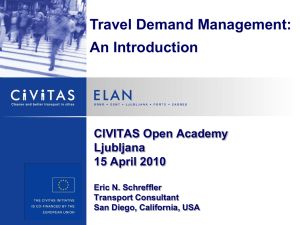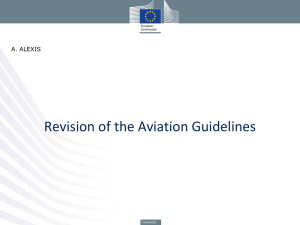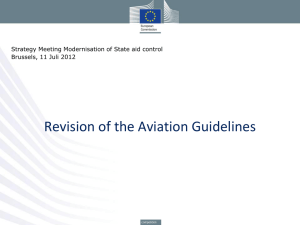3 Business Analyst TRB_Final_Draft_3_Arturo_Bujanda
advertisement
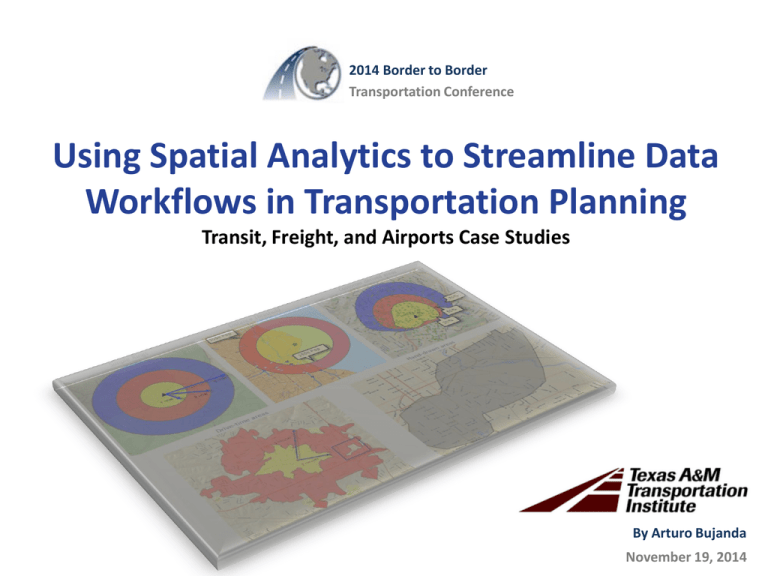
2014 Border to Border Transportation Conference Using Spatial Analytics to Streamline Data Workflows in Transportation Planning Transit, Freight, and Airports Case Studies By Arturo Bujanda November 19, 2014 Agenda Objectives Objective What is spatial intelligence and geoanalytics? Data structure Geoanalytic tools useful in transportation planning Case studies Assisting transportation planning efforts Conclusion 2 Project objectives Explore the application of spatial intelligence (SI) and geoanalytics to streamline data workflows in transportation planning. Provide guidance for practitioners to: • Analyze demographic, social, economic, and transportation trends. • Conduct geospatial analyses useful in travel demand modeling (TDM), transit, freight and airport planning applications. 3 Agenda Objective What is spatial intelligence intelligenceand andgeoanalytics? geoanalytics? Data structure Geoanalytic tools useful in transportation planning Case studies Assisting transportation planning efforts Conclusion 4 Spatial intelligence and geoanalytic tools Combine GIS analysis and visualization capabilities with extensive data packages that are constantly updated in the cloud. Represent an innovative alternative to integrate datasets and spatial tools from multiple sources (eg. the cloud) to solve complex transportation problems. Have the potential to become standardized procedures for updating travel demand models (TDM) in many transportation agencies. 5 Spatial Intelligence and Geoanalytic Tools: Main Interface of Esri Business Analyst (BA) 6 Agenda Objective What is spatial intelligence and geoanalytics? Data Data structure structure Geoanalytic tools useful in transportation planning Case studies Assisting transportation planning efforts Conclusion 7 BA combines wizard-driven data in the cloud, ready to use, and easier to manage and share Updated demographics and income profiles with forecasts for up to five years. Census 2010 demographics and a summary profiles. Tapestry segmentation area profiles. Consumer spending for retail goods and services. U.S. businesses by industry, sales volume, location, name, employees. The 2005–2009 data from the ACS is available in GISready format 8 BA provides the following levels of geography for data analysis: U.S. Sate Core-based statistical area (CBSA) Designated market area (DMA) County County subdivision Place Zip code Tract Block group Congressional districts 9 Agenda Objective What is spatial intelligence and geoanalytics? Data structure Geoanalytic Geoanalytic tools toolsuseful usefulinintransportation transportationplanning planning Case studies Assisting transportation planning efforts Conclusion 10 Tools in BA were designed to assist solving a variety of business-critical purposes, including: Target-marketing, analyzing customers, site selection, and designing territories and routes. Examples include: • Enhancing Shopping Center Performance ArcNews, Winter 2010/2011. • A Formula for Revitalization ArcUser, Summer 2010 • PETCO Improves Location Selection Integrated Solutions for Retailers, May 2010 • Finding Success in a Soft Economy ArcNews, Spring 2009 • The Who, What, Where, and How About Customers, Constituents, Donors ArcNews Online, Winter 2008/2009 Nonetheless, we have found that some of such tools offer great potential for their application in TDM and transportation planning purposes 11 Settings for Data Apportionment Areas 12 Agenda Objective What is spatial intelligence and geoanalytics? Data structure Geoanalytic tools useful in transportation planning Case studies studies Assisting transportation planning efforts Conclusion 13 Construction of Traffic Analysis Zones (TAZ) Project objective: develop a travel demand model (TDM) that integrates two border communities in a binational conurbation into a single transportation and economic system. The integration of BA with in TDM efforts proved valuable for the construction TAZs, the collection of socioeconomic and demographic data, and loading the TDMs. Income differentials between the two cities, in two different countries, made it impossible to compare socioeconomic data. BA allowed us to successfully process and integrate data for the overall binational conurbation for its subsequent input in a TDM. This case study not only demonstrates the effectiveness of using the extensive BA data package for the US, but also the use of custom layers and tools to create TAZs as the case of the Mexican AGEBs. 14 Original TAZs and AGEBs merged into resultant Super-zones and were used to extract data from BA 15 Demographic Analysis of Bus Rapid Transit (BRT) Corridor (Galicia, 2010)1 Project objective: estimate current and projected population by stop or corridor for bus-rapid transit (BRT) ridership forecasting using BA. Galicia (2010) demonstrated that it was possible to obtain demographic data using BA along any given stop or BRT corridor in the US. Obtained reliable information avoiding data requests to other agencies. BRT stations were set as retail stores in BA, and passengers were treated as customers of the BRT according to the location and other amenities (ie. walking distance). 1. Cabrera, Luis David Galicia. Decision Support Tools for Bus Rapid Transit Corridor Planning. Civil Engineering, The University of Texas at El Paso. Ann Arbor, MI: ProQuest LLC. 2010. UMI: 3433512. 16 Business centers in BA 2010 and BRT stops along the Las Vegas MAX BRT line (Galicia, 2010)1 17 BA Trade Area Creation Process Used to Extract Demographic Data (Galicia, 2010)1 1. Cabrera, Luis David Galicia. Decision Support Tools for Bus Rapid Transit Corridor Planning. Civil Engineering, The University of Texas at El Paso. Ann Arbor, MI: ProQuest LLC. 2010. UMI: 3433512. 18 Service Coverage Area for Las Vegas MAX along the BRT Corridor (Galicia, 2010)1 19 Identification of freight generation clusters for potential intermodal terminal locations Project objective: examine the potential viability for an alternative transportation system for trailers and containers in a binational, cross-border setting. The Freight Shuttle is designed to move trailers and containers, via automated transporters, over distances of 5 to 500 miles on an emission-free, electric-powered guideway system. • www.freightshuttle.com BA was a crucial tool for the market study, the analysis of the location of potential customers, and the exploration of potential terminal locations in the El Paso–Juarez binational region. 20 Identification of Freight Generation Clusters for Potential Intermodal Terminal Locations 21 Airports Analysis and Planning: Measuring Surface Accessibility Project objective: examine and document the role of aviation along the Texas-Mexico border, and identify border-specific issues and challenges. According the National Plan of Integrated Airport Systems (NPIAS), most Americans reside within 20 miles of an airport. This case study explores the surface accessibility of an airport to population leaving in regions within a 50 mile buffer of the Mexican border. BA was the tool of choice to assess their impact on analyzed airports in Texas and Mexico. Of the current total U.S. population of 306 million people, all but 5.6 million live within 20 miles of a NPIAS airport considering reliever and general aviation airports. 22 Driving Distances from the Mexico Border System Airports Based on Primary Highways 23 24 Real Influence (Cross-Border) Area of Texas Airports 25 Driving Times from the Texas Border Airports: 10, 20, and 40 minutes 26 27 Agenda Objective What is spatial intelligence and geoanalytics? Data structure Geoanalytic tools useful in transportation planning Case studies Assisting Assisting transportation transportationplanning planningefforts efforts Conclusion 28 Streamline Workflows in Transportation Planning Metropolitan agencies face the challenge of administering data that is not uniform, consistent, or timely, which translate into inefficiencies with negative impacts for transportation planners. Many government and businesses are harnessing big data and the cloud to solve complex problems. However, some transportation planning agencies seems to lag behind such efforts. Integrating SI and geoanalytics in transportation planning and TDM efforts is a convenient way for doing things smarter, better, and faster. Information often used by retailers to market to their customers offers an underexploited potential to assist solving many urban planning and TDM problems. 29 As demonstrated by the airports case study: BA played a crucial role for making possible the analysis of 31 airports and their relationship to each other as a system without the need of a single data collection trip or data request to any state or local agency. 30 Facilitates seeing beyond the data Represents an innovative, on-demand alternative to leverage tools and datasets from multiple sources (e.g., collecting data from the ACS, appraisal districts, MPOs). As demonstrated in the BRT case study, you can create quick site analyses by simple ring, drive-time, or threshold trade areas, and produce demographic reports as point and polygon features (e.g. the TDM case study). BA offers an optimized way to search and target areas that meet your specific criteria, such areas are based on zip-codes, blocks, or any custom geography level. For example: For example, in the airports case study suppose you want to target moderately dense populated areas with middle income families who tend to spend money on air travel. You might want to search the following: • Population between 10,000 and 30,000 people • Avg household income of over $75,000 • Median age of 25–50 years 31 Prevents the data lag problem The ACS is expected to provide a more frequent flow of information to the transportation planning community, the process of inspecting, cleaning, transforming However, modeling data at most agencies is often characterized by: • • • Low and fragmented asset utilization Duplication of datasets and efforts Long procurement lead times. Until the change towards the cloud from state and local transportation and planning agencies is complete, a significant amount of the data products from state and local agencies would remain with limited access from the transportation planning and research community. 32 Promotes collaboration Conducting transportation planning projects distant from the regions of study becomes a tedious process, often prone to errors or frequent data collection trips from researchers and consultants to the study area. Cloud services allow access to background maps and additional data, and share maps with the online community. 33 Agenda Objective What is spatial intelligence and geoanalytics? Data structure Geoanalytic tools useful in transportation planning Case studies Assisting transportation planning efforts Conclusion 34 Conclusion GIS is an essential tool for transportation planners in helping to collect, process, and visualize data commonly used by transportation planners. Given the continually evolving advances in GIS technologies, this paper serves only as a starting point documenting the capabilities of spatial analytics to solve data, TDM, and similar transportation planning issues. This research explored the integration of SI and geoanalytics to streamline workflows in TDM and transportation planning efforts highlighting its benefits. Our six case studies explored in this paper demonstrated an innovative, faster, and smarter alternative to integrate datasets from multiple sources. Until state and local transportation agencies complete their migration to the cloud, SI and geoanalytic applications seem a logic alternative to streamline data workflows. 35
